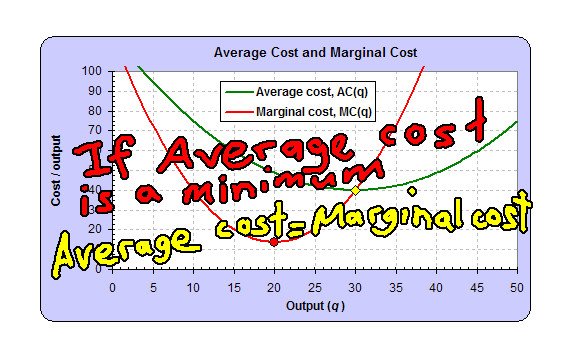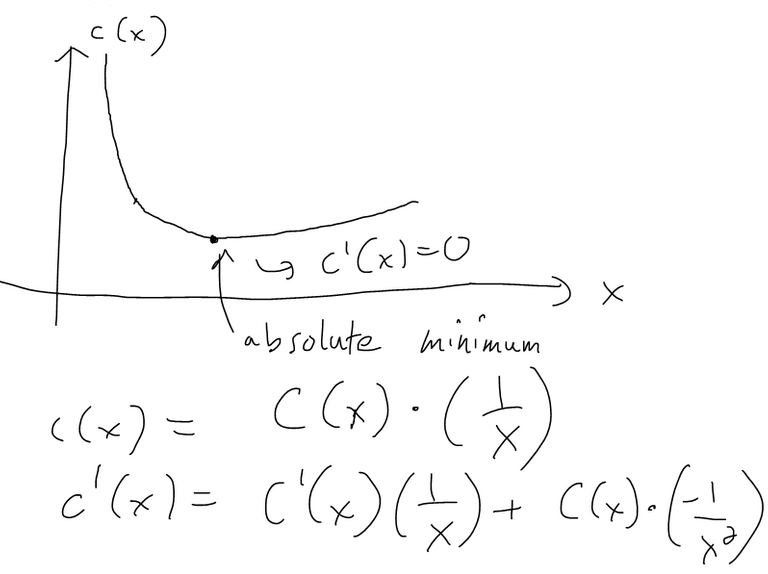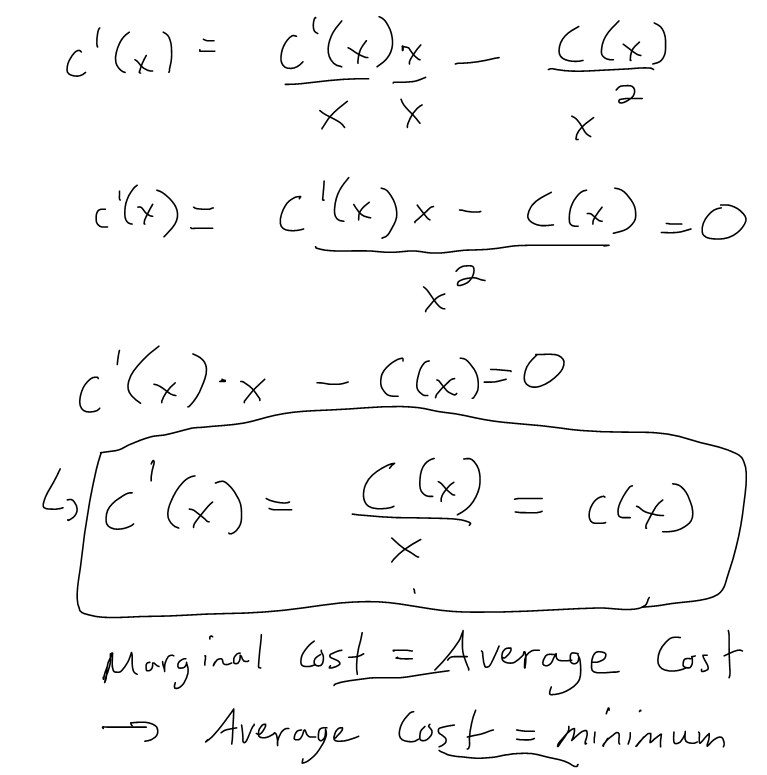Marginal Cost vs Average Cost - Economics 101
In this video I look further into economics and show that the average cost of producing one item when x items are produced is minimum when the average cost equals the marginal cost. This is an important principle to understand and it is easily derived using the calculus principles that I have covered in my previous videos.
Watch video on:
- 3Speak:
- Odysee: https://odysee.com/@mes:8/marginal-cost-vs-average-cost-economics:4
- BitChute: https://www.bitchute.com/video/FSuRGg7ECsST/
- Rumble:
- DTube:
- YouTube: https://youtu.be/HiMaLvsTstc
Download video notes: https://1drv.ms/b/s!As32ynv0LoaIiaRy5yrdPAR0OuzVZg?e=bZD1yr
View Video Notes Below!
Download these notes: Link is in video description.
View these notes as an article: https://peakd.com/@mes
Subscribe via email: http://mes.fm/subscribe
Donate! :) https://mes.fm/donate
Buy MES merchandise! https://mes.fm/store
More links: https://linktr.ee/matheasy
Follow my research in real-time on my MES Links Telegram: https://t.me/meslinks
Subscribe to MES Truth: https://mes.fm/truthReuse of my videos:
- Feel free to make use of / re-upload / monetize my videos as long as you provide a link to the original video.
Fight back against censorship:
- Bookmark sites/channels/accounts and check periodically
- Remember to always archive website pages in case they get deleted/changed.
Recommended Books:
- "Where Did the Towers Go?" by Dr. Judy Wood: https://mes.fm/judywoodbook
Join my forums!
- Hive community: https://peakd.com/c/hive-128780
- Reddit: https://reddit.com/r/AMAZINGMathStuff
- Discord: https://mes.fm/chatroom
Follow along my epic video series:
- #MESScience: https://mes.fm/science-playlist
- #MESExperiments: https://peakd.com/mesexperiments/@mes/list
- #AntiGravity: https://peakd.com/antigravity/@mes/series
-- See Part 6 for my Self Appointed PhD and #MESDuality breakthrough concept!- #FreeEnergy: https://mes.fm/freeenergy-playlist
- #PG (YouTube-deleted series): https://peakd.com/pg/@mes/videos
NOTE #1: If you don't have time to watch this whole video:
- Skip to the end for Summary and Conclusions (if available)
- Play this video at a faster speed.
-- TOP SECRET LIFE HACK: Your brain gets used to faster speed!
-- MES tutorial: https://peakd.com/video/@mes/play-videos-at-faster-or-slower-speeds-on-any-website- Download and read video notes.
- Read notes on the Hive blockchain #Hive
- Watch the video in parts.
-- Timestamps of all parts are in the description.Browser extension recommendations:
- Increase video speed: https://mes.fm/videospeed-extension
- Increase video audio: https://mes.fm/volume-extension
- Text to speech: https://mes.fm/speech-extension
--Android app: https://mes.fm/speech-android
Economics – Marginal Cost vs Average Cost

If average cost is minimum then marginal cost = average cost
Cost function, C(x)
- cost to produce x amount of items
Marginal Costs, C’(x) - Derivative of C(x)
- Rate change of C(x)
- Approximately cost to produce 1 more item
- If x is a large number
- .e. x = 1000 cars. C’(x) = cost to produce the 1001st car (approximately)
- If x is a large number

Economies of Scale:
- More efficient use of the fixed costs of production
- Decreased marginal costs
- Cost function concave downwards
Eventually there will be an inflection point and the cost will concave upwards (marginal costs increase), perhaps because of overtime costs or the inefficiencies of a large-scale operation.
Average Cost, c(x)
- Cost per item when x items are produce

- Slope of the line that joins the origin to the point (x, C(x) on the C(x) curve


- The above principle is plausible because if our marginal cost is smaller than our average cost, then we should produce more, thereby lowering the average cost.
- If the marginal cost is larger than our average cost, then we should produce less in order to lower our average cost.
https://twitter.com/442160704/status/1599525009315487744
The rewards earned on this comment will go directly to the people( @mes ) sharing the post on Twitter as long as they are registered with @poshtoken. Sign up at https://hiveposh.com.
Thanks for your contribution to the STEMsocial community. Feel free to join us on discord to get to know the rest of us!
Please consider delegating to the @stemsocial account (85% of the curation rewards are returned).
You may also include @stemsocial as a beneficiary of the rewards of this post to get a stronger support.